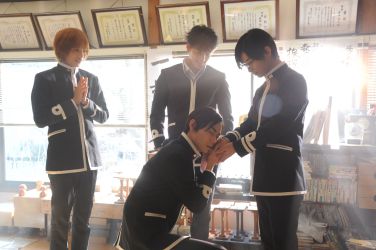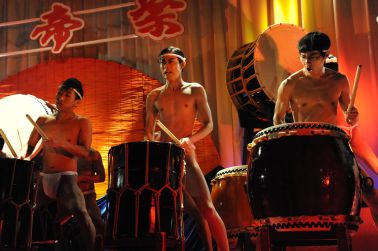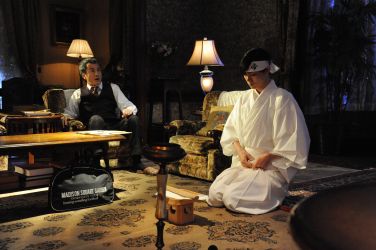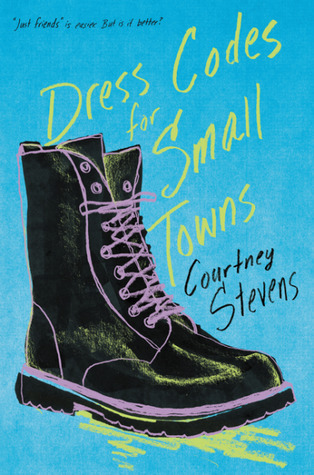
“A pleasant and often funny ride exploring high-school life in the Showa era, but, unfortunately, it doesn’t raise above the standard affair, and the comedy, as over-acting so typically of Japanese comedy is present, remains something of an acquired taste.”
Introduction
When it comes to adaptations to the silver screen, Mangaka Usamaru Furuya is not doing that bad. In 2016 his horror comedy manga Litchi☆Hikari Club found his way into movie theaters. And now with Teiichi: Battle of Supreme High a second manga by his hand is given the live-action treatment.
This time, the live-action adaptation is given to Akira Nagai, a relatively unknown director, who might be known for his second full-length feature, last year’s If Cats Disappeared From the World. Can Akira Nagai’s approach bring manga adaptation to a higher level than normally is the case?
Review
Showa Era Japan. Teiichi Akaba (Masaki Suda) has the dream to become the prime minister of Japan, so that he will be able to create his own country. For that purpose, he enters New Kaitei high school, an all boys high-school which is know to be the incubator for future politicians and bureaucrats. The plan to attain his goal is clear as crystal: the first step is to become the student body president in New Kaitei high, and then become a member of the political faction consisting of past presidents. But, alas, more people share the same dream, like Kikuma Togo (Shuhei Nomura). The competition will be fierce.

To pave the road to become president, Teiichi and Komei Sakakibara (Jun Shison) decide to support Himura Roland (Shotaro Mamiya) in the coming election. Everything is going perfect, but then Josuke Akaba (Kotaro Yoshida), Teiichi’s father, uncovers that Himura’s father is the president of an american car company, who lost a lot of money because of his protectionist policies. Kikuma Togo, Teiichi’s arch-rival, informs Himura Roland of this connection.
 Even though the representation of Japanese school life in the Showa era might be a little bit over the top – often becoming a parody as such, there are some elements evoked in the narrative that are still relevant for the current state of Japanese school system (narra-note 1). This is already sensible in the main narrative driving force of inter-student competition, which evokes the focus on achieving and attaining high grades so highly present in Japanese high school “society”. While the focus in attaining one’s dream is praiseworthy, the narrative does show subtly the effects of such a singular focus, a focus on winning, how it can structure one’s life, and how it can define one’s relations (narra-note 2). In this respect, Teichii: battle of supreme high also reveals how the unfulfilled dreams of fathers can be forced upon to next generation, fathers desiring that their sons realize what they couldn’t, and that sons sometimes have to fight the wars of their fathers. But the narrative does not hesitate to underline that such forcing always goes against the subjectivity of the subject as such.
Even though the representation of Japanese school life in the Showa era might be a little bit over the top – often becoming a parody as such, there are some elements evoked in the narrative that are still relevant for the current state of Japanese school system (narra-note 1). This is already sensible in the main narrative driving force of inter-student competition, which evokes the focus on achieving and attaining high grades so highly present in Japanese high school “society”. While the focus in attaining one’s dream is praiseworthy, the narrative does show subtly the effects of such a singular focus, a focus on winning, how it can structure one’s life, and how it can define one’s relations (narra-note 2). In this respect, Teichii: battle of supreme high also reveals how the unfulfilled dreams of fathers can be forced upon to next generation, fathers desiring that their sons realize what they couldn’t, and that sons sometimes have to fight the wars of their fathers. But the narrative does not hesitate to underline that such forcing always goes against the subjectivity of the subject as such.
 The narrative features, not surprisingly, a lot of familiar Japanese high-school events like the opening ceremony, school festival, and the student council election. And while these elements have already been used, on way of another, in a variety of high school narratives, be it drama or movies, these elements are rather refreshingly approached in Teiichi: Battle of Surpreme High.
The narrative features, not surprisingly, a lot of familiar Japanese high-school events like the opening ceremony, school festival, and the student council election. And while these elements have already been used, on way of another, in a variety of high school narratives, be it drama or movies, these elements are rather refreshingly approached in Teiichi: Battle of Surpreme High.
The narrative is guided by Teiichi’s speech that acts as narrative voice, the spectator following the subjective position of Teichii in the narrative space. While it might be true that we follow Teiichi’s position from a narrative perspective, the cinematography has a broader scope, revealing the various sides (e.g. the relation between Kikuma Togo and his father, the rivalry between Togo’s father and Teiichi’s father, … etc.) in the ongoing battle of supremacy. This approach has the benefit of making the narrative deeper and richer, as it puts Teiichi’s battle into a broader perspective.
 The cinematography is a mix between fixed shots and, often subtle, moving shots – shots moving vertically as well as horizontally in the narrative space. One or two energetic and refreshing compositions are to be noted (cine-note 1) and a variety of techniques like slow-motion are used (cine-note 2). The cinematography often tries to subtly capture the feel of a manga, painting the narrative into a sort of live-action anime, giving various scenes a pun-like structure. In this respect, the various over-the-top shots, which can be read as a form of fan service, easily reveal the narrative’s manga-origin. And with characters making grand gestures, very expressive facial expressions and having theatrical speech once in a while, the over-the-top feel is also felt in the acting performances as such, painting each character truthfully to its manga counterpart on the silver screen.
The cinematography is a mix between fixed shots and, often subtle, moving shots – shots moving vertically as well as horizontally in the narrative space. One or two energetic and refreshing compositions are to be noted (cine-note 1) and a variety of techniques like slow-motion are used (cine-note 2). The cinematography often tries to subtly capture the feel of a manga, painting the narrative into a sort of live-action anime, giving various scenes a pun-like structure. In this respect, the various over-the-top shots, which can be read as a form of fan service, easily reveal the narrative’s manga-origin. And with characters making grand gestures, very expressive facial expressions and having theatrical speech once in a while, the over-the-top feel is also felt in the acting performances as such, painting each character truthfully to its manga counterpart on the silver screen.
Teichii: Battle of surpreme high might be lighthearted, with moments of slap-stick comedy and the kind of homo-eroticism fans of manga have come to love, but for all its lightheartedness, the narrative also underlines that sons should never fight their fathers battles, but find their own subjectivity and own dream to attain in life. In general, Teichii: Battle of surpreme high is a pleasant and often funny ride exploring high-school life in the showa era, but, unfortunately, it doesn’t raise above the standard affair, and the comedy, as over-acting so typically of Japanese comedy is present, remains something of an acquired taste.

Notes
Cine-note 1: In one instance, a shot is used to underline and support the narrative speech of Teichii figuratively.
Cine-note 2: In some instances shaky shots are also used, but their use have a particular reason. When Dan Otaka is going home and Teichii and Komei are following him, shaky shots underline the fact that Dan is being followed by them.
Narra-note 1: These aspects include for instance the expected discipline, the structure and inner-workings of a school council, … .
Narra-note 2: Furthermore, because the narrative constitutes a certain comedic view on high-school competition, one cannot fail to feel a certain criticism of contemporary school-life lingering through the narrative.
Advertisements Share this:




